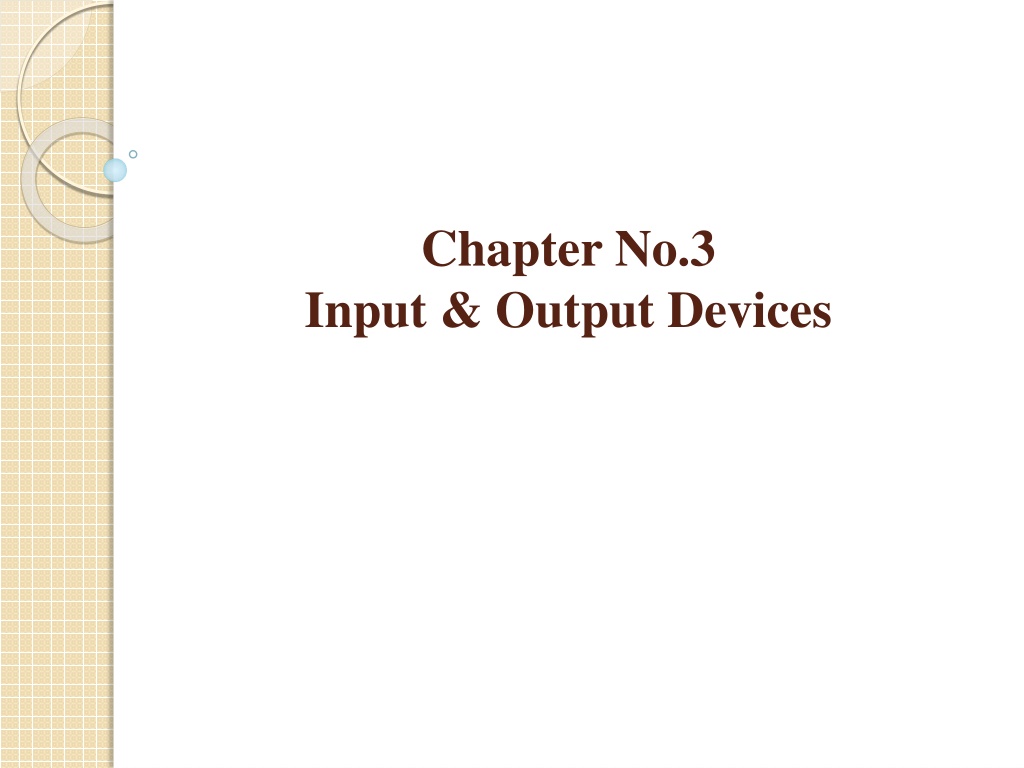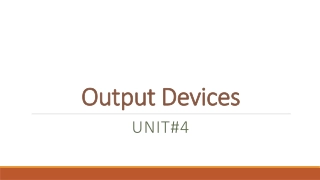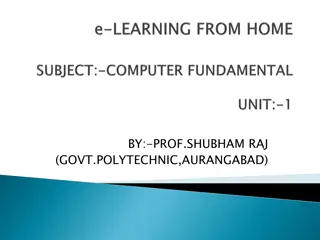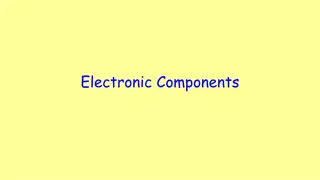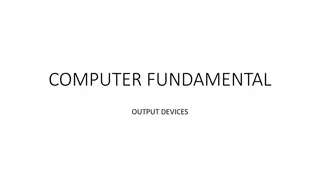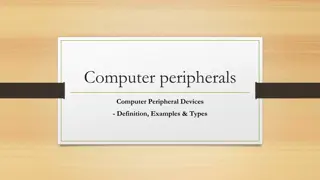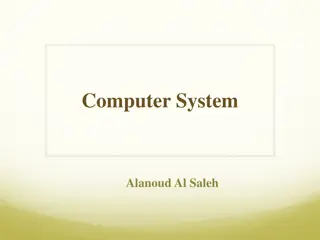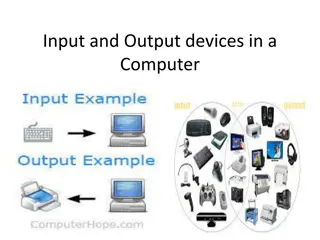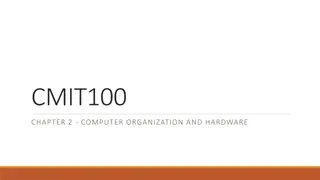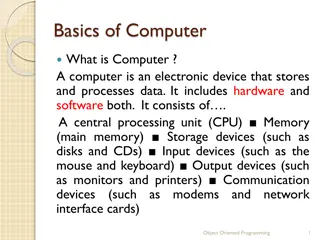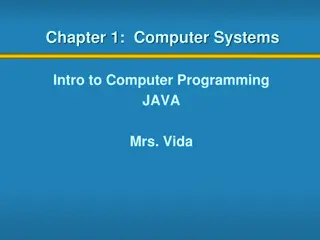Understanding Computer Output Devices
Explore the world of computer output devices with a focus on monitors, printers, and flat-panel displays. Discover the different types of monitors, including CRT and flat-panel displays, along with their features and characteristics. Learn about the functionality of printers and the distinction between impact and non-impact printers in the digital realm.
Download Presentation

Please find below an Image/Link to download the presentation.
The content on the website is provided AS IS for your information and personal use only. It may not be sold, licensed, or shared on other websites without obtaining consent from the author. Download presentation by click this link. If you encounter any issues during the download, it is possible that the publisher has removed the file from their server.
E N D
Presentation Transcript
Chapter No.3 Input & Output Devices
Output Devices Following are some of the important output devices used in a computer Monitors Plotter Printer
Monitors Visual Display Monitors, commonly called as Unit (VDU), are the main output device of a computer. It forms images from tiny dots, called pixels that are arranged in a rectangular form. The sharpness of the image depends upon the number of pixels.
Types of Monitors There are two kinds of viewing screen used for monitors. Cathode-Ray Tube (CRT) Flat-Panel Display
Cathode-Ray Tube (CRT) Monitor The CRT display is made up of small picture elements called pixels. The smaller the pixels, the better the image clarity or resolution. It takes more than one illuminated pixel to form a whole character, such as the letter e in the word help. A finite number of characters can be displayed on a screen at once. The screen can be divided into a series of character boxes - fixed location on the screen where a standard character can be placed. Most screens are capable of displaying 80 characters of data horizontally and 25 lines vertically.
Flat-Panel Display Monitor The flat-panel display refers to a class of video devices that have reduced volume, weight and power requirement in comparison to the CRT. You can hang them on walls or wear them on your wrists. Current uses of flat-panel displays include calculators, video games, monitors, laptop computer, and graphics display.
Categories of flat-panel display The flat-panel display is divided into two categories Emissive Displays Emissive displays are devices that convert electrical energy into light. For example, plasma panel and LED (Light- Emitting Diodes). Non-Emissive Displays Non-emissive displays use optical effects to convert sunlight or light from some other source into graphics patterns. For example, LCD (Liquid-Crystal Device).
Printers Printer is an output device, which is used to print information on paper. There are two types of printers Impact Printers Non-Impact Printers
Impact Printers Impact printers print the characters by striking them on the ribbon, which is then pressed on the paper. Characteristics of Impact Printers are the following Very low consumable costs Very noisy Useful for bulk printing due to low cost There is physical contact with the paper to produce an image
Types of Impact Printers These printers are of two types Character printers Dot Matrix Printer(DMP) Daisy Wheel Line printers Drum Printer Chain Printer
Character Printers Character printers are the printers which print one character at a time. These are further divided into two types: Dot Matrix Printer(DMP) Daisy Wheel
Dot Matrix Printer In the market, one of the most popular printers is Dot Matrix Printer. These printers are popular because of their ease of printing and economical price. Each character printed is in the form of pattern of dots and head consists of a Matrix of Pins of size (5*7, 7*9, 9*7 or 9*9) which come out to form a character which is why it is called Dot Matrix Printer. Advantages Inexpensive Widely Used Other language characters can be printed Disadvantages Slow Speed Poor Quality
Daisy Wheel Head is lying on a wheel and pins corresponding to characters are like petals of Daisy (flower) which is why it is called Daisy Wheel Printer. These printers are generally used for word-processing in offices that require a few letters to be sent here and there with very nice quality. Advantages More reliable than DMP Better quality Fonts of character can be easily changed Disadvantages Slower than DMP Noisy More expensive than DMP
Line Printers Line printers are the printers which print one line at a time. These are of two types Drum Printer Chain Printer
Drum Printer This printer is like a drum in shape hence it is called drum printer. The surface of the drum is divided into a number of tracks. Total tracks are equal to the size of the paper, i.e. for a paper width of 132 characters, drum will have 132 tracks. A character set is embossed on the track. Different character sets available in the market are 48 character set, 64 and 96 characters set. One rotation of drum prints one line. Drum printers are fast in speed and can print 300 to 2000 lines per minute. Advantages Very high speed Disadvantages Very expensive Characters fonts cannot be changed
Chain Printer In this printer, a chain of character sets is used, hence it is called Chain Printer. A standard character set may have 48, 64, or 96 characters. Advantages Character fonts can easily be changed. Different languages can be used with the same printer. Disadvantages Noisy
Non-impact Printers Non-impact printers print the characters without using the ribbon. These printers print a complete page at a time, thus they are also called as Page Printers. Characteristics of Non-impact Printers Faster than impact printers They are not noisy High quality Supports many fonts and different character size
Types of Non-Impact Printers These printers are of two types Laser Printers Inkjet Printers
Laser Printers These are non-impact page printers. They use laser lights to produce the dots needed to form the characters to be printed on a page. Advantages Very high speed Very high quality output Good graphics quality Supports many fonts and different character size Disadvantages Expensive Cannot be used to produce multiple copies of a document in a single printing.
Inkjet Printers Inkjet printers are non-impact character printers based on a relatively new technology. They print characters by spraying small drops of ink onto paper. Inkjet printers produce high quality output with presentable features. They make less noise because no hammering is done and these have many styles of printing modes available. Color printing is also possible. Some models of Inkjet printers can produce multiple copies of printing also. Advantages High quality printing More reliable Disadvantages Expensive as the cost per page is high Slow as compared to laser printer
Plotters A plotter is a special output device used to produce hard copies of large graphs and designs on paper, such as construction maps, engineering drawings, architectural plans and business charts. The plotter is either a peripheral component that you add to your computer system or a standalone device with its own internal processor.
Types of Plotters Following are two types of plotter Drum Plotter Flat-Bed Plotter
Drum Plotter The drum plotter was the first output device for printing graphics. A drum plotter contains a pen, drum, paper, and ink for output. In this drum rotates the pages and pens draw the images on papers. The drum rotates to change the position of the paper. The length of image is limited. It is because of the limited size of the drum.
Flatbed Plotter A flatbed plotter is used with many CAD programs for designs. In this plotter writing pen move x-axis and y- axis direction to draw the image. The papers remain stationary on the surface of the flatbed plotter. Different types of pens are used to draw a colorful sketch. The size of the images depends on the size of the flatbed plotter.
Speakers Speakers with computer systems. They receive audio input from the computer's sound card and produce audio output in the form of sound waves. are popular output devices used
Headphones Headphones are small speakers that can be worn in or around your ears. Traditional headphones have two ear cups attached by a band that is placed over your head. Smaller headphones, often called earbuds or earphones, are placed inside the outer part of your ear canal.
